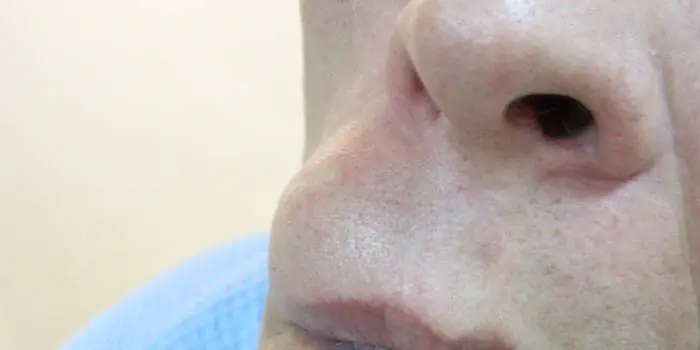There is an opinion that atheroma can resolve on its own. However, official medicine refutes it and offers only its removal in various ways as a treatment for atheroma.
What is atheroma?
A benign tumor of the sebaceous glands is called atheroma or epidermal cyst. It is a small formation, round in shape, dense and mobile to the touch. This neoplasm forms in areas of the skin where there is a lot of sebaceous gland. The main reason for the formation of atheroma is blockage of the sebaceous gland and impaired outflow of sebum.
Causes of blocked sebaceous glands:
- Increased sweating
- Thickening of the stratum corneum of the skin,
- Disturbances in the natural exfoliation of the top layer of skin,
- Hormonal changes that increase the viscosity of glandular secretions,
- Neglect of personal hygiene,
- Occupational hazards,
- Use of antiperspirants.
Due to these reasons, the outflow of the contents of the sebaceous glands in the body is disrupted. This occurs due to the fact that too much sebum is secreted or an obstacle forms at the exit of the duct in the form of a keratinized layer of skin, narrowing of the duct or blocking with particles of cosmetics, as well as due to skin contamination.
How does atheroma manifest?
Atheroma looks like a formation in the thickness of the skin; it is a small ball, smooth to the touch and movable. The neoplasm is quite dense and has clear boundaries. Sometimes in the center you can see a dark dot - the exit of the sebaceous gland duct. Atheromas do not cause painful sensations. The contents of this tumor are a white, mushy mass containing desquamated epidermis and sebaceous gland secretions.
Atheromas can form either single or several times. In size they reach 4-5 cm.
- Chin,
- scalp,
- Armpit area,
- Skin of the back and neck,
- The area of the genital folds.
Is atheroma dangerous? These tumors do not cause direct harm to health, however, large tumors in a visible place cause psychological discomfort, interfere under clothing, and, depending on their location, can compress nearby tissues and vessels, disrupting metabolic processes. In addition, the prolonged existence of atheroma can cause inflammation and even suppuration. In this case, the neoplasm becomes painful, a subcutaneous abscess forms, the skin around it turns red, swells, and the temperature may rise. When an abscess forms, it may spontaneously open, then the accumulated sebum-like contents and pus are released from the tumor.
Treatment of atheroma
If a neoplasm is detected on the body, you should immediately consult a doctor, who will carefully examine you, do the necessary research and determine the nature of the tumor. If it is atheroma, then given its small size, the doctor may recommend not resorting to any intervention. If the tumor is large, bothers the patient, spoils the appearance, or there is a threat of suppuration, then treatment will be prescribed.
Is it possible to squeeze out atheroma? In principle, this is possible. But only part of its contents will come out, the rest will remain in place, and another part will end up in the deeper layers of the skin and become a source of formation of new atheroma or inflammation.
Can atheroma go away on its own? There are cases when atheroma resolves, but according to the results of clinical practice, this happens extremely rarely. The vast majority of atheromas do not go away. If the doctor decides to remove them, then you can choose one of three methods: surgical, radio wave or laser. The operation is simple; radio wave or laser methods of removal allow this to be done with minimal trauma to the skin. There are usually no scars or marks left.
The prognosis is favorable, and the probability of re-development of atheroma is about 3%.
Atheroma is a benign tumor that can appear at any time on hairy areas human body.
Often this follicular cyst is filled with its own secretions - a cheesy or pasty substance that has an unpleasant odor.
In this article we will tell you how to remove atheroma.
How to get rid of a tumor?
The cause of such a neoplasm is blockage of the sebaceous gland. One of the factors that provokes the appearance of atheroma is damage and subsequent blockage of the sebaceous canal. It forms a capsule containing sebaceous secretions, epithelial particles and small hairs - this is the contents of the atheroma.
In cases where an infection attaches to the contents of the capsule, the mass becomes purulent and acquires a rather unpleasant odor. Often the tumor has a hole in the middle through which the substance filling the capsule is released.
Atheromas can be like single, so multiple. The only and most effective way of treatment such a tumor is its removal.
As mentioned above, the most preferred method of treating atheroma is its removal using radical methods:
- laser;
- radio wave knife;
- as well as surgical excision.
The essence of surgical removal is to remove the tumor with all its membranes - this is the only way avoid relapse of the disease. Surgical intervention to remove atheroma takes place on an outpatient basis and is quite short-term. The procedure is performed under local anesthesia. First, the skin over the tumor is dissected, then the atheroma capsule is removed.
Attention: it is necessary to achieve complete cleansing of the surrounding tissues from all particles of the neoplasm, otherwise atheroma can grow back. After removal, the skin is sutured and a sterile compress is applied to the wound. Purulent atheromas, after surgery, must be drained.
Another method of tumor therapy is laser exposure. Such interference less traumatic and is used for small growths or purulent atheromas. After laser removal almost there is no relapse of the disease, and the recovery period is quite fast. Laser intervention techniques:
- Photocoagulation - a kind of evaporation of the cyst - is carried out to excise neoplasms about 0.5 cm in size. After such an intervention, sutures are not required on the wound, since a crust forms at the site of manipulation, under which the healing process takes place. Soon the crust falls off and a small scar remains on the skin.
- Evaporation of the capsule is also carried out with a laser and is used for fairly large tumors, more than 20 mm in diameter. This operation requires surgery. Excision of the cyst takes place in two stages: first, the contents of the atheroma are removed, then the wound is slightly stretched, and then the capsule is evaporated with a special laser knife. A drainage is installed and the incision site is sutured. Sutures are removed 8-10 days after surgery.
In addition to surgical and laser removal, excision of atheroma can be carried out using radio waves. A special knife, based on the action of specific waves, is aimed directly at the tumor, killing atypical cells and tissues of the cyst itself. After such manipulation on the skin not even a trace remains, since there is not even a minimal incision on the skin. The procedure is also does not require hair removal near the tumor, which makes it optimal for the treatment of tumors on the face and neck.
Can it go away on its own and resolve?
The neoplasm itself never and by no means does not resolve. Even if you pierce the tumor with a needle and squeeze out its contents, the cavity (capsule) will still remain, which will lead to the formation new atheroma.
But if the pathology is asymptomatic and does not bother the patient, it is better not to rush to remove it, but to observe the tumor see a dermatologist.
What to do if it hurts and itches?
Often, atheroma begins to bother its “owner” - quite painful sensations appear at the site of the growth and unbearable itching. The skin around the tumor becomes red and inflamed. This happens when it enters the affected sebaceous gland. infections.
If on time do not start treatment such atheroma, inflammatory process passes into the deeper layers of the epidermis, and the atheroma itself may burst. Therapy for an inflamed tumor is somewhat different from conventional treatment - first the inflammatory process in the tumor is relieved, and then it is excised.
Without surgery
This method of therapy is possible with the help of traditional medicine advice. Most often used for this Vishnevsky ointment or homemade garlic ointment with vegetable oil. Such products must be applied to the neoplasm or rubbed into its surface, secured with a band-aid. Such manipulations must be carried out several times a day, preferably at night.
Treatment of atheroma at home using Ichthyol ointment or Linimenta balsamic is necessary at the very beginning of the process of wen formation. If the growth opens on its own, it is necessary to thoroughly clean its cavity from the contents, disinfect the wound and surrounding skin using wound healing agents.
Attention: when choosing remedies for the treatment of atheroma on your own, it is necessary to take into account possible contraindications and side effects. In addition, therapy for a wen is more successful only at the very beginning of its development; an advanced and expanded tumor will most likely require surgical removal.
Prevention
After surgery it is necessary to carefully follow all doctor's instructions:
- change the dressings covering the open wound daily;
- Take antihistamines, painkillers and antibiotics prescribed by your doctor.
Depending on the size of the tumor and the absence or presence of an inflammatory process, the presence of a scar after surgery can be predicted.
After the wound begins to heal and its edges are stitched (or glued with special medical glue), it is necessary to use a plaster that protects the wound from germs and pathogenic microorganisms.
In some cases that have deviations from the normal healing process, the surgeon carries out an individual treatment procedure for such a patient.
Important: when removing a suppurating cyst, as well as in the case of incomplete enucleation of its capsule, relapses of atheroma are possible - its repeated formation and growth.
Useful video
In the video below, you will learn how to cure atheroma:
Patient reviews of surgery to remove atheroma are almost always positive. Regardless of the type of intervention, it always painless and is not associated with negative experiences. But there are also some negative aspects. Some types of atheroma excision are not so cheap, in addition, they leave scars that do not always disappear, which have to be removed in a cosmetologist's office. But in general, absolutely all methods of getting rid of pathology guarantee an almost complete absence of relapses and a complete cure for atheroma.
Any neoplasm on the body does not look aesthetically pleasing, therefore, even if it does not pose a threat to health, you have to think about its removal. Atheroma on the face (or wen) is one of the benign tumors that arise under the skin due to blockage or malfunction of the sebaceous glands. Despite its harmlessness, the neoplasm can lead to inflammation of nearby tissues, since a foreign body compresses them, disrupting blood microcirculation.
What is atheroma on the face
According to the unified classification of diseases (ICD - 10), the tumor has code D23. Atheroma on the face is a benign retention-type formation that occurs in the sebaceous gland. This explains the location of the tumors - areas of the body where many alveolar glands are collected (they are also called seborrheic zones), for example, the forehead, nose and nasolabial triangle, ears, skin behind them, cheeks, eyelids, etc.
Symptoms of atheroma
For a long time, the epidermal cyst may not appear visually. The formation under the skin grows slowly: the process can take a year or more. In this case, a tumor is formed under the skin, in which a secretion consisting of lipid, cholesterol and dead epithelial cells accumulates. The size of the capsule (wen) varies greatly - from a few millimeters to a 5-7 cm diameter.
As a rule, a person notices visual symptoms of atheroma on any or several areas of the face. What does a subcutaneous pathological neoplasm look like? Facial atheroma is characterized by:
- dense structure, which is determined by palpation;
- mobility of the skin over the formation, inability to form a fold in this area;
- the cyst on the face under the skin has an even round shape (resembles a soft ball);
- the epidermis in the tumor area does not differ in color/structure;
- simple atheroma on the cheek or elsewhere on the face does not cause pain;
- the neoplasm is prone to suppuration and inflammation, and these processes are painful and stimulate an increase in skin temperature in the area of the wen;
- a purulent sebaceous gland cyst on the face looks like an abscess (swollen neoplasm with white contents)

Causes of atheroma
The only cause of the disease is blockage of the sebaceous gland on the face due to increased density or impaired outflow of sebum. Different conditions can provoke this process. Such factors are divided into internal and external, the latter including:
- bad ecology;
- heat;
- work in highly polluted conditions;
- use of oil-based cosmetics.
Internal causes of atheroma are:
- oily seborrhea;
- bacterial growth on the face (insufficient skin hygiene);
- hyperhidrosis;
- heredity;
- acne;
- impaired metabolic processes;
- hormone imbalance.
In men, a factor provoking the disease may be an increased amount of testosterone produced and irregular shaving of the beard/mustache. In newborn babies, a cyst on the cheek, as a rule, indicates the presence of maternal hormones. Doctors often associate the appearance of oily warts with the effect of cosmetics with a thick texture on the skin (as a rule, these are oil-based products that clog pores).
Atheroma in a child
Benign formations on the face are more common during puberty, when adolescents begin puberty. However, experts sometimes diagnose a tumor in small children, including newborns. Atheroma in a child of this age is provoked by the accumulation of fatty secretions, as a result of which the gland duct is clogged. Possible causes of pathology in children may be:
- increased sweating;
- insufficient skin hygiene;
- wearing clothes that are too warm (overheating of the body) or things made of synthetic materials;
- changes at the hormonal level.
Atheroma can occur due to improper functioning of the endocrine system. In addition, children with excess weight, acne and acne are predisposed to pathology. The disease in a newborn indicates defects during the intrauterine formation of the epidermis. The reason for this anomaly is unknown, but some experts associate it with the diet and lifestyle of the woman bearing the fetus.

Can atheroma resolve on its own?
In rare cases, the neoplasm may disappear without surgical intervention, but you should not hope that the atheroma will resolve on its own. If your doctor advises you to remove the tumor, you should listen to him. A tumor under the skin can be removed in one of three ways: radio wave, surgical excision or laser. Getting rid of a tumor is easy: to reduce the risk of skin damage and scarring, it is better to choose a laser or radio wave method. Relapse after treatment is extremely unlikely - the tumor reoccurs in only 3% of cases.
Treatment of atheroma
Before starting treatment for the disease, atheroma is diagnosed, which consists of a visual examination of the patient and palpation of the tumor. To accurately determine the nature of the tumor, histology (analysis under a microscope) is done. This event makes it possible to establish the presence of atheroma under the skin even when visually it is practically indistinguishable. Gradually, the volume of contents in the cyst increases, which causes the growth of a tumor under the skin.
If you do not begin timely treatment of atheroma, the tumor will become large and can rupture, resulting in tissue infection. To avoid such consequences, it is important to resort to such a treatment measure as surgical removal of the atheroma. Conservative (use of drugs) and traditional methods of treating a tumor are powerless in this case, so cleansing the cyst cavity is carried out by resection, that is, the tumor is removed along with the capsule.
Treatment of atheroma without surgery
If you treat the disease without surgery, you should not expect a quick effect. In addition, only a few achieve positive results using traditional methods and the use of medications, while the condition of the tumor under the skin continues to worsen. If you try to open the capsule yourself, there is a high risk of developing sepsis, since it is impossible to thoroughly clean the cyst at home.
Treatment of atheroma without surgery is highly not recommended, however, if the tumor has ruptured on its own, you need to carefully wipe the wound with a sterile cotton pad, cover it with a bactericidal plaster and consult a doctor (dermatologist or surgeon). The specialist will clean the wound cavity, preventing suppuration or relapse of atheroma. Only surgery can guarantee with almost 100% probability that the tumor will not re-form under the skin.

Surgical methods
If atheroma has formed on the face of a small child (under 7 years old), then the only suitable treatment method is to remove the capsule with a scalpel, laser or radio waves under general anesthesia. In adults, this procedure is performed under local anesthesia. Unlike classic excision with a scalpel, other methods of surgical intervention do not leave visible marks on the skin and minimally injure blood vessels. In addition, laser and radio wave procedures eliminate the need for postoperative measures.
Removal of atheroma on the face with laser
The method is indicated for small tumors without tissue inflammation. Removing atheroma on the face with a laser leaves virtually no scars or scars and does not disturb the subcutaneous microflora. The technique belongs to the bloodless category, and the wounds left after the operation heal quickly. The average duration of the procedure is 20 minutes. If atheroma is removed from the scalp, the patient does not need to pre-shave. The laser treatment method almost completely eliminates the likelihood of relapses.
Atheroma after removal
After excision of a large tumor, the wounds are sutured, and the sutures are removed after about a week (with normal healing process). After removal, atheroma should be treated daily with an antiseptic solution such as Betadine. In addition, in the first few days the wound site should not be wetted. Dressings after surgery are carried out if the source of the disease is in the area of clothing friction. Until the wound is completely healed, it is recommended to treat the skin with Levomekol and Vishnevsky balm.
Treatment of atheroma with folk remedies
Therapy of a neoplasm using non-traditional methods can be carried out only if the symptoms of the disease are not pronounced. At the same time, the most effective are considered to be rubbings, compresses and ointments that are prepared independently at home. Treatment of atheroma with folk remedies may include:
- Ointment for swelling on the skin of the face with burdock. Mix the plant, ground using a meat grinder, with pork fat, leave the mixture in the dark for 3 days. Lubricate the atheroma with the resulting product 1-3 times daily.
- Onions against neoplasms (wen) of skin water. You can reduce the swelling like this: mix the same amount of baked onions with laundry soap, after grinding the ingredients. Apply the mixture to the atheroma, covering the skin with a sterile bandage on top. Change the compress twice a day.
- Lamb fat for adipose tumor. Melt the product and rub it into the affected area of the skin until completely absorbed. Continue using fat until the symptoms of the skin disease decrease.

Prevention of atheroma on the face
Neoplasms arise due to a violation of the outflow of sebum, which occurs due to blockage of pores, therefore the prevention of atheroma on the face should be based on regular cosmetic procedures for cleansing the skin. These include:
- visiting the sauna;
- steam baths;
- cleansing masks;
- massages.
To reduce facial skin oiliness, you should use special tonics and cleansers. In addition, preventing the development of tumors on the skin of the face should include proper, balanced nutrition. So, with high fat content of the skin, you need to exclude fatty and carbohydrate-rich foods from your diet. If the tumor recurs after removal of the tumor, you should definitely contact an endocrinologist who will help determine the causes of the disease.



